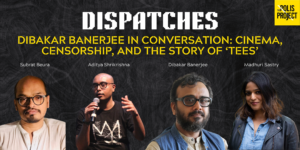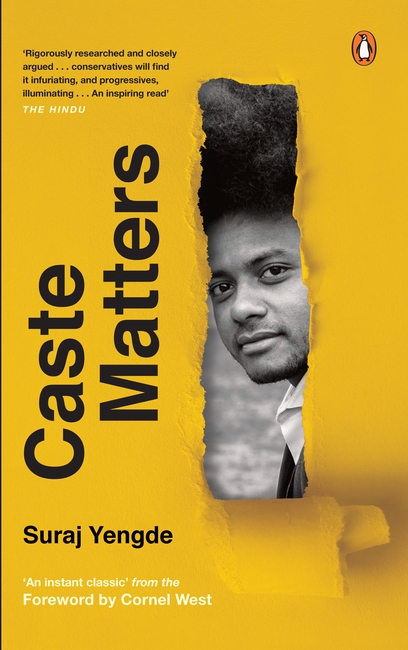

Suraj Yengde’s latest book, Caste Matters, has received a very mixed response. Though some of the more prominent Dalit voices have been very critical of the contents as well as the form, others have written in favor of it. Positive responses came from a wide spectrum: The Wire’s review hailed it as setting a new agenda for the Dalits in India and Roundtable India, an online platform for mostly young Dalit–Bahujan Ambedkarite scholars, also carried a negative response by five research scholars from the Jawaharlal Nehru University to an excerpt carried in The Hindu as well as an article in “defense” of the book and its author.
I read the book with an open mind, very conscious that any self-reflexive project, as Suraj has attempted, carries the risk of being misunderstood, even maligned and criticized severely, as much as being appreciated and applauded. I may add that the same holds for the reviewer. Having had two or three opportunities to discuss a number of issues with Yengde in the recent past, I conclude that he is quite a grounded and organic intellectual. And since I also write in the same field, I must confess that the critique levelled against the book – that it lacks a structure and not always successfully rambles between personal memoir and critical analysis – is merited to a great extent. But more on this later. When the book first came out, I got a message from one well known academic asking me to write to Penguin and critique their lack of editorial control over the text. I hadn’t read the book then and said as much.
The book begins with an Introduction with recollections of his childhood in a very disadvantaged home, but with a most affectionate grandmother, and gives an overview of the forthcoming six chapters: Being a Dalit, Neo-Dalit Uprising, The Many Shades of Dalits, The Dalit Middle Class, Dalit Capitalism, Brahmins against Brahminism. Chapters 3, 4 and 5 appear to have raised the most hackles among the Dalit readers for their critical remarks on the community.
It is one thing to critique the book as lacking sufficient structure; it is another, however, to say that the conclusions and arguments the book offers are not well-founded. The book puts the Dalits under a relentless magnifying glass and describes a picture that is not always pretty – especially in the case of some of those who have been upwardly mobile both professionally and economically. But plenty of evidence is offered to justify the critique, based on personal experience, both in India and abroad. Ambedkar towards the end of his life wrote in similar vein and in anguished terms about this section of society; needless to say, it leaves a sour taste in mouths of the Dalit middle class readers who, for better or worse, have been the ones articulating the aspirations and experiences of the Dalits particularly in recent years.
The sub-caste issue; the Dalits who try to “pass off” as non-Dalit and try their best to obscure their ancestry and their past; the Dalit Capitalists, who have been recently ascendant in the public and economic sphere; those who take advantage of reservation, but fail to give back to the community; those who have entered the affluent classes and raise their children with no conception of their Dalit ancestry – all these are singled out for rather trenchant criticism. Yengde categorizes the Dalit middle class as Token Dalits, Elite Dalits, Self-Obsessed Dalits, Radical Dalits and uses strong epithets to describe them. There is no doubt that this has caused a fair bit of heartburn among today’s English-speaking Dalits who can afford to buy and read hard-bound books.
However, the book does make a very important point – that the Dalit issue is not only of the Dalits alone, nor yet of the government, but – as it is a massive human rights violation – it should be seen as a moral, ethical, social, political and even philosophical challenge to anyone in the world. Hence, he points out that there is a need for the oppressors, not just the Brahmins, but for anyone who subscribes to the ideology of caste, to be part of the struggle to end its stranglehold on Indian society and on the lives of hundreds of millions of people. The author discusses, though not in sufficient depth, the struggles of Blacks in America for the liberation from slavery and for a new social contract between the Blacks, the American people and the State. Yengde discusses the ideas of two black leaders of the early 20th century: Booker T Washington and W E B Dubois in their divergent approaches to the progress of the Black community in the US. While dissecting the weakness of the approach of Booker T Washington, who pinned his hopes on skill training and regular work and wages, he contrasts it with W E B Du Bois’ focus on human dignity, freedom, political power, civil equality and rights and higher education as the basis of Black struggle.
Yengde critiques the relatively new project of building economically strong Dalits through Dalit Capitalism advocated by some notables in the community as being insufficiently radical or empowering. He discusses Ambedkar’s policy approach in this context and highlights the focus on the people’s struggle against capitalist forces. Ambedkar’s idea was a “modified form of state socialism” with “an emphasis on economic productivity” ; he was skeptical of private capital and “feared the replication of wealth inequality that was the result of land ownership-caste monopoly in India.”(p. 215) Yengde is therefore dismissive of the impact that “Millionaire Dalits” would have “without a dynamic vision for change” (p. 219).
Comparing racism debates and struggles in the US with the caste discourse in India, the author points out the inescapable fact that many critical voices against racism and white privilege are raised by white people themselves. There is wide popular liberal support to struggle of Blacks and minorities from a large number Whites, including those with wealth and privilege, who do not hesitate to critique their own privilege and try to understand how it operates to continue to oppress and deny justice to the blacks in the US (pp 242-245). It is this factor that is lacking in today’s India, he points out. In the last chapter, Yengde discusses how during both Phule’s and Ambedkar’s struggles, young Brahmins were among the most supportive, counted among the closest in the inner circle to these giants, and paid huge personal and social costs to stand with the struggle for justice for the Dalits and Other Backward Classes.
However, in post-independent India one hardly ever sees Brahmins working closely in support of the leaders of Dalit struggles. While there are a handful of Brahmins who are supportive and even take public positions, their number is hardly sufficient to make a dent in the brahminical superstructure in which caste persists and continues to flourish against every struggle and legal provision. Media, economy, academia, religious structures, political power, government, private sector, even public sector institutions – all these continue to ride on the proximity to the ideology of brahminism and caste inequality.
It only remains to point out that the book is not without its (relatively small) faults. I myself struggle to write on similar topics, being the first-generation postgraduate in my family with no formal training in academic writing. I appreciate the huge effort made by the author to articulate the very nuanced and sensitive issues with which one struggles in mainstream writing and literature. For instance, Yengde successfully explores the failure of leftist intellectuals to include Dalits in the revolutionary project but also points out, perspicaciously, that leftist movements implicate the “Western imperial order as the central problem while remaining blind to the local, everyday caste oppressions in the new capitalist caste market”. So “a Dalit has to feel the pain of the capitalist exploitation of his counterparts in Asia, Africa and North America… [he] remains agentless in the left discourse” and is “limited only to his working-class self” (p. 235).
One of the biggest criticisms of the book is that it reads like a personal narrative. I agree that it is so, but I would argue that this is its strength. When seeking to build meaning and knowledge in fresh areas of work, one has to blaze the path oneself. Writing on the Dalit situation in 21st century India, one has to break new ground given the dynamic and fluid nature of the society and politics of the day. Hence it is no surprise that the author employs a combination of personal narrative and academic discussion. In fact, he does so in a very engaging manner, for instance, by bringing his childhood experiences of going to the market in his slum, and of the exploitative bania shopkeepers there, into the discussion of Dalit Capitalism and succeeds in showing how the project of Dalit Capitalism is far removed from Babasaheb’s economic vision and is inimical to the overall economic and social development of Dalits. Therefore, far from being critical of this approach, I would say that the book is a good example of how organic and grounded individuals write about issues concerning their communities, free from the constraints of being “objective,” formal or “structured.” This is a way of building people’s knowledge and experience into theory, a way to build theory from the ground upwards – something that is, sadly, still a novelty in academic circles. Surely knowledge building from the people’s perspective cannot be expected to squeeze into formal theoretical molds or models, and like life, will need to have the space and opportunity to grow and expand.
The book, however, doesn’t sufficiently foreground the concerns of Dalit women. Even though it begins with and is often peppered with reminiscences of his grandmother, mother, and other women, and there is only a brief specific section on Dalit women in the 3rd Chapter and overall the discussion is mostly centered around the experiences and situations of male Dalits and male leaders. Considering the pivotal role Black women play in the struggle against racism and in articulating their situation, and since Yengde has had a long engagement with the Black struggles in the US and Africa, I would have expected at least a full chapter to discuss the role of women in the Dalit struggles and resistance – how they keep the families together and go to extreme lengths to nurture community and younger generation; how they preserve the culture and identity while bearing, with hard work, endurance, much love and goodwill, their exploitation, violence, poverty and ill-health, to which the author makes numerous references throughout the book. In the discourse around caste, women matter too.
Also, it is women, whether Dalit or Black, and some of the more active men in the community who epitomize the suggestion for a radical social transformation: that of Dalit Love, which the author asserts is “an effective antidote to the malady of caste… [t]he only force in India that can accommodate the ignorant and uphold the virtues of compassion” (p. 50). This Love needs to be supported with a politically charged vision. To love and grow together is resistance, he adds (p. 51).
The caste ecology is unwilling to abandon its conditions and therefore it fears and hates the Dalits who are capable of this radical Love, causing the literal murder of dozens of young Dalits, women and girls.
Caste Matters thus places a square challenge before every thinking Indian – and indeed, every human being, to make a principled choice to stand on the side of justice, human dignity and freedom, democratic values – and a socially transforming radical Love.
Suraj Yengde, Caste Matters, Penguin India, New Delhi, 2019; pp 325; ISBN 978-0-670-09122-5





